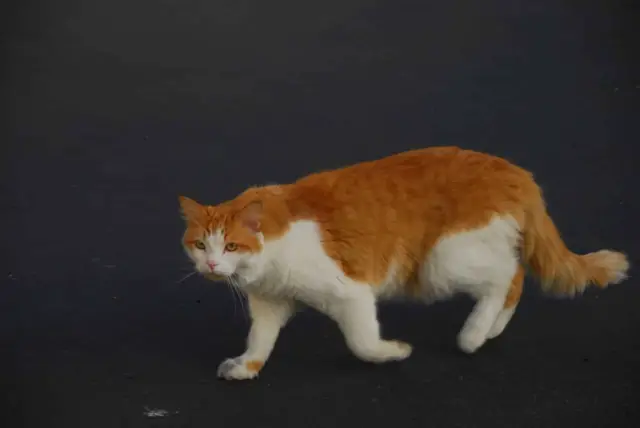
Cats have always fascinated humans with their graceful and agile movements. Whether they are leaping effortlessly from one surface to another or stalking their prey, their walking style is a sight to behold. In this article, we will delve into the intricacies of cat walking and compare it to the gait of two other remarkable creatures: camels and giraffes. By understanding how cats walk and the unique features of their gait, we can gain valuable insights into the evolutionary adaptations that have shaped their bodies.
Understanding the mechanics of cat walking
To comprehend how cats walk, it is crucial to examine the mechanics behind their movements. Cats are digitigrade animals, which means they walk on their toes rather than the soles of their feet like humans. This anatomical feature allows for a more efficient use of energy and provides better balance and control during locomotion.
When a cat takes a step, it places its hind paw almost exactly where its front paw was, creating a straight and narrow walking path. This is known as a direct register walk. Unlike humans, who have a symmetrical gait, cats move both their left legs simultaneously and then their right legs, resulting in a distinctive pattern of movement.
Comparing cat walking to camel walking
While cats and camels may seem worlds apart, their walking styles share some surprising similarities. Camels also have a digitigrade walking style, relying on their toes for locomotion. However, unlike cats, camels have long legs and a unique foot structure that enables them to traverse sandy deserts and other challenging terrains. Camels move both their legs on one side of their body at the same time, creating a rolling motion that helps them conserve energy and maintain balance in the arid landscapes they inhabit.
Despite these similarities, the mechanics of cat walking differ significantly from that of camels. Cats have a more fluid and graceful gait, with each step appearing effortless. In contrast, camels have a distinct swaying motion due to the synchronized movement of their legs. These differences in walking styles highlight the diverse adaptations that animals have developed to navigate their respective environments.
Analyzing the gait of giraffes
Giraffes, with their long necks and towering height, possess a walking style that is truly unique. As quadrupeds, giraffes walk on all four legs, but their gait is distinct from both cats and camels. With each stride, a giraffe’s front and back legs on one side move simultaneously, creating a rocking motion that propels the animal forward. This walking style, known as lateral sequence, allows giraffes to cover vast distances while conserving energy.
Unlike cats and camels, giraffes have an elongated and slender body structure, which contributes to their elegant walking style. The long legs of a giraffe enable it to take large steps, and their necks provide them with a wide field of vision, allowing them to spot predators or sources of food from a distance. The gait of a giraffe reflects the evolutionary adaptations that have shaped its body to thrive in its natural habitat.
Similarities and differences in cat, camel, and giraffe walking
Although cats, camels, and giraffes all have distinct walking styles, there are some similarities in their locomotion. All three animals are digitigrade, meaning they walk on their toes. This adaptation provides them with increased speed, agility, and balance. Additionally, they all exhibit a synchronized movement of their legs, although the pattern and rhythm differ among the three species.
On the other hand, there are notable differences in the walking styles of these animals. Cats have a direct register walk, placing their hind paws precisely where their front paws were, resulting in a narrow track. Camels, on the other hand, move both legs on one side simultaneously, creating a rolling motion. Giraffes have a lateral sequence gait, where the legs on one side move together, producing a rocking motion.
These differences in walking styles are a reflection of the unique anatomical and physiological adaptations each species has developed over time. The environment in which they live, their body structure, and their evolutionary history have all contributed to the distinctive ways in which cats, camels, and giraffes move.
Factors influencing cat walking behavior
While the basic mechanics of cat walking are consistent across individuals of the same species, various factors can influence their walking behavior. One such factor is the cat’s size. Larger cats, such as lions and tigers, have a more robust build and longer limbs, which can affect their walking style. Additionally, the texture and stability of the surface they are walking on can also impact their gait. Cats are known for their ability to adjust their walking style to different terrains, whether it be a soft carpet or a rocky surface.
Another crucial factor that influences cat walking behavior is their mood or intent. Cats are highly adaptable animals, and their walking style can change depending on whether they are relaxed, hunting, or in a playful mood. When hunting, cats adopt a stealthy and deliberate walking style, minimizing noise and maximizing their chances of capturing prey. Understanding these factors provides valuable insight into the complex nature of cat walking behavior.
Evolutionary adaptations in cat walking
The unique walking style of cats is the result of millions of years of evolution. Cats are descendants of ancient carnivorous ancestors that roamed the Earth long ago. Over time, they have developed a body structure and walking style that allows them to be efficient predators. The digitigrade walking style of cats provides them with several advantages, including increased speed, agility, and the ability to silently sneak up on their prey.
Another noteworthy adaptation in cat walking is their retractable claws. Unlike camels and giraffes, cats have the ability to extend or retract their claws depending on the situation. This allows them to maintain a firm grip on various surfaces while walking and climbing. The retractable claws also protect the sharp tips from wear and tear, ensuring their effectiveness when needed for hunting or self-defense.
The role of body structure in cat walking
The body structure of cats plays a significant role in their unique walking style. Their flexible spines and powerful hind limbs provide them with the ability to jump and leap with ease. Cats have a highly articulated backbone, which allows them to twist and turn their bodies mid-air, providing them with exceptional agility.
Furthermore, the length and proportion of their limbs contribute to their graceful movements. The hind limbs of cats are longer than their front limbs, which enables them to generate powerful propulsion when walking or running. This asymmetrical limb length, combined with their flexible spine, allows cats to achieve incredible speeds and execute precise movements.
Cat walking myths debunked
There are several myths and misconceptions surrounding cat walking that need to be debunked. One common misconception is that cats always land on their feet, regardless of the height from which they fall. While cats have a remarkable ability to orient themselves mid-air and twist their bodies to land safely, this does not mean they are immune to injuries from high falls. Cats can sustain serious injuries if they fall from great heights, and it is essential for their owners to take precautions to prevent such accidents.
Another myth is that cats walk silently. While cats are indeed known for their stealthy movements, they do make noise while walking. However, their walking style minimizes the sound they produce, allowing them to approach their prey undetected. The soft pads on their paws and the digitigrade walking style help reduce the impact and noise they make when walking on various surfaces.
Insights into the unique walking style of cats compared to camels and giraffes
In conclusion, the walking style of cats is a fascinating subject that offers valuable insights into their evolutionary adaptations and predatory nature. Cats’ digitigrade walking style, direct register walk, and retractable claws are all features that contribute to their elegance and efficiency in locomotion. While there are similarities in the walking styles of cats, camels, and giraffes, each species has developed unique adaptations suited to their respective environments and body structures.
By exploring how cats walk and comparing their gait to camels and giraffes, we gain a deeper appreciation for the diverse ways in which animals move. Understanding the mechanics and factors that influence cat walking behavior helps us comprehend the complexity of their movements and the evolutionary history that has shaped their bodies. So, the next time you observe a cat gracefully striding across the room, take a moment to marvel at the secrets unveiled behind their captivating walking style.
If you enjoyed my article, I would appreciate you sharing it with your network.

Sima Ndlebe
Sima writes for CatBuzz. He is interested in Cats, Health and Fitness, and Entrepreneurship.
Published: 14 December 2023



